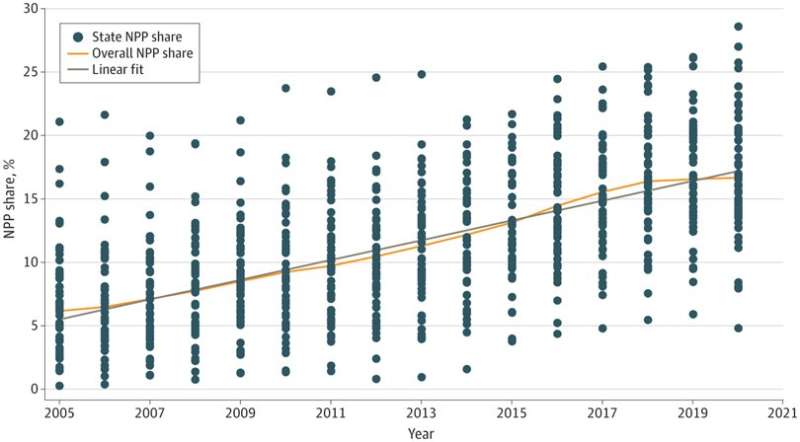Non-physician practitioners in the ED associated with 5.3% more imaging use

A new Harvey L. Neiman Health Policy Institute study found when patients are treated in the Emergency Department (ED) by non-physician practitioners (physicians assistants and nurse practitioners), there were 5.3% more imaging studies performed than if patients were seen only by physicians. This JAMA Network Open study was based on a nationally representative sample of Medicare fee-for-service beneficiaries with 16,922,274 ED visits between 2005 and 2020.
The increased imaging associated with non-physician practitioners was due to both a greater likelihood of an ED visit having imaging (3.4% increase). "While our study notes the correlation between the presence of non-physician practitioners in the ED with more imaging, it does not make any judgment about the efficacy of this increase in imaging," stated Eric Christensen, Ph.D., director of Economic and Health Services Research at the Neiman Institute. "The variation we found in practice patterns between physicians and non-physician practitioners highlights an opportunity to ensure the judicious use of imaging. These efforts need to address both when and what imaging is appropriate."
"To put this 5.3% imaging increase in context, it equates to more than one million imaging studies per year when applied to the roughly 20 million annual ED visits for the entire Medicare fee-for-service population," Christensen noted. "Although we focused on Medicare, there are approximately 130 million annual ED visits in the United States, so this figure could be substantially higher."
When the research team examined the specific imaging modalities, "We found that the presence of non-physician practitioners in the ED was associated with increases of 3.2% for radiography, 7.3% for CT, and 14.2% for other modalities (MRI and ultrasound)," stated co-author Richard Duszak, MD, professor and chair of the Department of Radiology at the University of Mississippi Medical Center. "Thus, the higher imaging associated with non-physician practitioners was most pronounced in these modalities in which we and others have observed rapidly increasing ED utilization."
The study noted that the share of ED visits managed by non-physician practitioners had steadily risen from 6.1% in 2005 to 16.6% in 2020.
"From an overall cost perspective, services rendered by non-physician practitioners have the potential to lower health care costs given that the Medicare Physician Fee Schedule pays for these services at 85% of what it pays physicians," stated co-author Timothy Swan, MD, Diagnostic and Interventional Radiologist, Marshfield Clinic Health System, Marshfield, WI.
"However, the increased imaging and other associated costs generated by these practitioners would offset these lower reimbursements. We did not address this cost question, but future research should explore the total cost impact of non-physician practitioners in the ED, considering both reimbursement and imaging orders."
More information: Eric W. Christensen et al, Association of State Share of Nonphysician Practitioners With Diagnostic Imaging Ordering Among Emergency Department Visits for Medicare Beneficiaries, JAMA Network Open (2022). DOI: 10.1001/jamanetworkopen.2022.41297



















